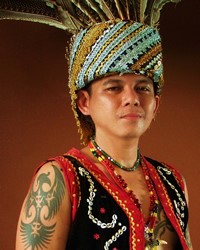Embaloh in Indonesia

Photo Source:
Anonymous
|
Send Joshua Project a map of this people group.
|
| People Name: | Embaloh |
| Country: | Indonesia |
| 10/40 Window: | Yes |
| Population: | 16,000 |
| World Population: | 16,000 |
| Primary Language: | Embaloh |
| Primary Religion: | Ethnic Religions |
| Christian Adherents: | 10.00 % |
| Evangelicals: | 4.00 % |
| Scripture: | New Testament |
| Ministry Resources: | Yes |
| Jesus Film: | No |
| Audio Recordings: | Yes |
| People Cluster: | Borneo-Kalimantan |
| Affinity Bloc: | Malay Peoples |
| Progress Level: |
|
Introduction / History
In the past, Mbaloh was a term widely used in Serawak and also in KalimantanBarat. They had been recorded and written by missionaries who spread Catholicism to the interior people in Kalimantan Barat. Apparently, these indigenous people referred to themselves as Banuak'a or indigenous of the land, and today, they are divided into a few Tamanic-speaking groups: a) Tamambaloh, who live in Batang Embaloh, b) Tamankapuas, who live in Putusibau and Medalam, c) Kalis, who live in the small Kalis River of Manday River. "Mbaloh" who moved to Sekadau and NangaTaman and didn't return back to their origin village are called Tamansesat Tamansekado and changed their language to Malayic.
Although in general these Tamanic group might disagree among themselves regarding their own different names of their tribes, all accept the term "Maloh" from outsiders. Today, most Embaloh can be found in Kapuas Ulu regency in Kalimantan Barat and they still live in Interior upriver of Embaloh. Maloh also can be found in some longhouse in Serawak, especially Lubok Antu Katibas river and Kapit but the majority of them had converted their language and culture into Ibanic and almost all of these Embaloh able to speak their own Tamanic mother tongue. Recently, a few Embaloh people migrated to central Sarawak to seek for better wage to suppo
What Are Their Lives Like?
The Maloh language falls under Tamanic categories, which is very different from their neighbors of Iban, Kantuq and Kaya 'an. A theory about the similarity of Embaloh and Bugis had made some ethnological researcher to conclude that Tamanic was related to Sulawesi culture but the local Embaloh-Tamanic doesn't find any similarity in language. Regarding their Tamanic heritage, the Embaloh believed that they had been indigenous to the region upriver of Embaloh and the name Embaloh was taken to indicate where they had been living for centuries. Embaloh class society are divided into a few groups: the Samagat (noble class) are mostly the headmen or medical/ritual experts, the Pabiring (middle class) are traders, the Banua (commoners) and the Pangkam (slave). Maloh villages are called Banua and may consist of a few row of longhouses called "Sau."
What Are Their Beliefs?
Western missionaries came to the interior of Borneo to spread Christianity during the Dutch colonial era. The Embaloh were among the first interior indigenous to convert to Catholicism and learn western education in the Catholic missionary school. Protestants also managed to convert Taman Kapuas, especially along the Sibau and Mendalam rivers. Catholicism and Christianity have become part of the Embaloh way of living even though animism and old traditional taboo and law still take place, especially in ritual ceremonies or traditional celebrations.
What Are Their Needs?
Embalohs need more spiritual hunger.
Prayer Points
Pray for Embaloh elders and family leaders to open the door to evangelism and discipleship.
Pray for Embaloh disciples who are zealous to spread the fragrance of Christ to their community and to others.
Pray that traditional barriers to the gospel would be broken down.
Pray for the Holy Spirit to bless Embaloh families with the realization that they need a sin-free Savior who offers abundant life.